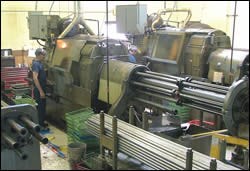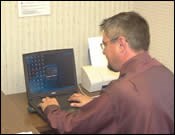Shop Management Software Helps All The Shop's Managers
Here’s a case where free shop management software proved so valuable to a company that it purchased three more seats of it in a short amount of time.
Things that a company gets for nothing usually turn out to be worth about what the company paid for them. However, here's a case where free shop management software proved so valuable to a company that it purchased three more seats of it in a short amount of time.
Efficient Machine Products Corp. (EMP), a precision machining firm in Strongsville, Ohio, did not have a formal shop management system. It had bits and pieces that had been created through the years: An Excel spreadsheet that would do one thing, a basic program that would do something else, and so on. The bits and pieces served their intended purposes; however, they did not work well together. Data residing in one program had to be manually re-entered in the others—a slow, labor-intensive task. Getting information from a particular program was difficult. All of the information was usable, but accessing it was too difficult and time consuming.
The problem did not seem important when the company was small. However, as sales increased, the company added more employees, moved to a larger plant and went from a single shift, 6 days a week, to around-the-clock operation, 7 days a week. As the organization grew, the limitations of its collection of homemade shop management tools became more apparent. Management finally realized that it needed a comprehensive, more organized and fully integrated system that would manage the enterprise more efficiently.
The company began investigating some of the more popular shop management software packages available on the market. When Patrick McGuckin, vice president of manufacturing for the firm, visited the Web site for Exact JobBOSS software (Minneapolis, Minnesota), a division of Exact Software North America, he discovered that the company was running a contest with its shop management systems as the prizes. He entered the contest and won a free seat of Exact JobBOSS for EMP—which pretty much decided the company's selection of a shop management system.
"If we had purchased the system, we probably would have started with one or two modules and added more over time as the need arose," Mr. McGuckin explains. "However, the software package that we won included almost all of the modules that the producer offers. That was a good start, because it allowed us to see how well the modules worked together."
Most articles written about software describe their use by one or more individuals within a specific department of the company—Estimating, CAD/CAM, Quality Control, and so forth. What impressed this EMP visitor about Exact JobBOSS right off the bat was the way that so many department managers were using the software to keep tabs on production at all times and manage their particular areas of responsibility more efficiently.
Mr. McGuckin uses the software's job control functions for job scheduling and process planning. After receiving a purchase order for a job, he uses Exact JobBOSS to assign the job to one or more machines. He also determines a delivery date for the job based on the existing load for the workcenter(s).
Using sales order information (material, order quantity, actual production quantity, pricing, and so forth) entered into Exact JobBOSS by the sales department, Mr. McGuckin uses the job entry software feature to create a "template" for the job. The template provides the basic part information used to create a job entry form for the initial job run; it also speeds and simplifies creation of job entry forms for any subsequent runs.
After the job has been assigned to a machine, a packet of information that includes the purchase order, a traveler identifying the various operations required for the part, inspection instructions, and so on, is prepared for the machine operator. "We try to provide instructions for every aspect of the job," Mr. McGuckin explains. "When things arise that we did not take into consideration, we add them to the job entry over time so that it becomes a constantly updated guide on how best to run the job."
The information also includes estimated setup time for the job and estimated cycle time for the part. EMP uses Exact JobBOSS to determine whether individual operators and the plant as a whole are meeting those times. "Enter the employee code number, indicate a particular date or period, and the program gives you an efficiency rating for that operator for the desired period," Mr. McGuckin continues. "Efficiency in this case means how close the operator came to matching the estimates for the jobs assigned. In addition to reports on individual operators, every month we get a combined efficiency report for the entire shop. The ratings range from 79 percent to 99.9 percent for the most recent combined report.
"Before we started using the shop management software, it took us hours to check our operating efficiency," he explains. "There were times when we did not have the time to do it. Now, we can get the results in minutes, and we can improve on our efficiencies because we have the time to focus on the causes of the problems."
Mr. McGuckin hastens to add that the problem is frequently not the fault of the operator. As often as not, the customer's requirements were not sufficiently spelled out—or changed since the last time the job was run—requiring an extra step to be added that wasn't in the initial job planning.
According to Mr. McGuckin, the clearer view that Exact JobBOSS provides of what's happening on the production floor has also helped EMP improve its on-time delivery performance. "Before, it was difficult to get a clear picture of where we were and what jobs were late," he explains. "People did not take the time to check on whether jobs were on schedule. Now, we can determine the status of any job in the shop in seconds. Now we can find those jobs that are running late, find out what the problems are that are causing the job to be late—and make the corrections quickly enough so that we can still get the job delivered on time."
Gary Edwards, EMP's plant supervisor for the day shift, is responsible for overall production and quality and spends a large part of his day analyzing Exact JobBOSS-generated employee, job and workcenter efficiency reports. He is also involved in a number of continuous improvement programs, one of which involves setup time reduction.
"While reviewing workcenter efficiency reports generated by Exact JobBOSS, I can quickly spot a machine that has idled too long for a setup," explains Mr. Edwards. "When a setup person exceeds 15 hours on a setup, that person, the lead man of that department and I get together to discuss the situation. With the many machines that we have, I can't mentally keep track of how long a particular machine has been idled for a setup. The 15-hour time limit is a big improvement over getting an efficiency report once a week and finding out that 60 hours went into a setup and that I wasn't aware of the problem.
"Thanks in part to the timely reports generated by our shop management software, we have reduced our setup times by about 25 percent and expect additional improvements," Mr. Edwards continues. "Faster setups are crucial to the growth of our company. Our production machines are primarily multi-spindle cam automatics that in the past, we would routinely set up for runs of hundreds of thousands or millions of parts. However, those large runs are gone. Today, we need to be able to handle runs as small as 2,500 parts—something we would never have considered in the past. The key to processing small runs economically is fast setups.
"We also use Exact JobBOSS to identify jobs with the same tooling requirements," he continues. "Although a job may not be due to ship for 6 months, it is often more efficient for us to run it ahead of time as one of a family of parts instead of having to completely change over a machine to run the job later. As an example of the setup time savings that are possible, we are currently running a family of parts where 17 hours of setup were required to run the first part in the family. However, only 5 hours of setup were required for each of the remaining parts in the family. As a result of our continuous improvement efforts, we have cut setup time for the first part in the family to 14 hours, and the setup time for the remaining parts in the family to 3 hours.
"I use Exact JobBOSS to monitor our production about 25 times per day," Mr. Edwards adds. "I check the workcenter efficiency reports for low numbers that usually mean one or more problems with a job. When a problem with a job surfaces, I can get on it right away. With our previous system, I would find out well after the fact that a job was running at 66 percent efficiency and had been for the last 5 days."
Every week, Mr. Edwards sits in on a planning meeting involving jobs scheduled to run the following week. In cases where the job is a repeat job, he consults job history information from shop management software to learn how well the job ran previously. He'll also check the workcenter efficiency report for the machine on which the job ran previously. When the numbers are low, he'll seek out the lead man and setup person who were involved with the job before to find out what, if any, problems occurred and if anything can be done to avoid them this time around. In this case, Exact JobBOSS provides clues that might enable the shop to handle the repeat job a bit more efficiently than the initial run. Mr. Edwards calls the software "one of the tools I need to be a successful plant manager."
Bill Strippy is EMP's business development manager. About 4 years ago, EMP moved to its current 35,000-square-foot facility. At the same time, it went from a one-shift operation to a three-shift operation 7 days a week to achieve the machine uptime benefits associated with around-the-clock operation. Mr. Strippy's primary job is to maintain the high level of production by filling open time on the machines as it arises. "We went from one and a half shifts at our former location to three shifts at our new facility, and when you are running only five machines out of 50 at night, you have a lot of idle capacity to put to work," he explains.
Mr. Strippy uses Exact JobBOSS to sell open time on the company's machines. He uses the backlog and scheduling data in the software to identify machine availability by type and size, and then goes after existing customers and prospects whose part sizes require those machine sizes.
In some cases, EMP may have declined to bid on jobs in the past because it couldn't meet the required delivery schedules. Mr. Strippy has a list of those companies he declined bids for, so when it's time to look for a job to run on a 1-inch multi-spindle, a Brown & Sharpe or a CNC machine, he'll contact those firms to inform them that in addition to offering quality parts at a competitive price, EMP is now able to provide quick delivery as well.
Mr. Strippy's aggressive marketing program has contributed to an impressive increase in EMP's sales of about 80 percent over the last 2 years. The company has added more than 25 new customers during that time period, accounting for about 200 new parts, most of which involve repeat orders.
Exact JobBOSS also enables EMP to offer faster deliveries and, in some cases, save the day for customers by coming through with parts on a crash basis. "Before Exact JobBOSS, we were quoting 6- to 8-week deliveries. Now, because we have more accurate estimates of the work in-house and the job backlog, we quote 3- to 5-week deliveries or less. We have some multi-spindle jobs coming in that must be fully tooled that we have committed to deliver in 2 weeks.
"With the shop management software, we have accurate information about our workload and can make intelligent decisions that won't hurt us or our customers. It's one thing to promise someone a fast delivery, but it doesn't make sense if you do it at the cost of being late with another customer's parts," Mr. Strippy continues.
"We have accomplished a great deal in the last few years: the relocation and expansion of the company, the explosion in sales, the expansion of our workforce, and the implementation of the shop management system. Also, we were able to do all this with the same core group of people," he notes. "When we started with the software, we weren't sure that we'd be able to handle it by ourselves, but the people who are managing the system today are the same people managing our production. There's a point of diminishing returns. Sometimes, more information only makes the enterprise more difficult to manage. In our business, we like to keep things as simple as possible, and Exact JobBOSS has helped us to do that.
Since EMP won its first seat of the software, the firm has purchased three additional seats. It is currently implementing a Quality Toolkit module to replace the custom-made program the company had been using. "The original software was not compatible with the new system," explains Paul Klonowski, quality manager for the shop. "By switching to the Quality Toolkit, the quality software will now be fully compatible with the rest of the shop management system."
One benefit of Toolkit over the earlier system is improved communication between quality control and manufacturing. When Mr. Klonowski uses the new software to write up a nonconformance report, he will be able to e-mail the report to other company managers, alerting them of the problem. Before this software, alerting everyone of the nonconformance took longer, and there was no assurance that the notification would be acted on promptly.
Another benefit is that the nonconformance report created by Toolkit is written in a corrective action format—something that the old system did not have. The report can be used to assign a person to investigate the causes of the nonconformance. The investigation remains open until the person performing the investigation completes the assignment. Also, the Toolkit has a place for indicating how the nonconformance was handled. If it is determined that the parts can be reworked, Toolkit keeps track of their disposition. A corrective operation can be added to the schedule where the software generates a traveler to accompany the parts that explains the corrective action.
EMP thinks that early detection and correction of problems will reduce the number of nonconforming parts, along with the reworking costs required to salvage them. "If our information about the production process is timely, then we'll be able to find and correct problems faster, allowing the job to run more efficiently," Mr. Klonowski explains. "The fewer nonconformances we have, the fewer number of parts that we must sort and rework—and the more good parts we can ship to the customer."
Mr. McGuckin concludes, "With Exact JobBOSS, visibility has improved greatly for everyone in terms of jobs to complete, backlogs, late payments, late vendors. It has made it easier for all of us to manage the enterprise."
Related Content
Mazak Device Enhances Machine Connectivity, Security
SmartBox 2.0 integrates advanced communication protocols and edge computing for enhanced productivity and security, ensuring safe data export from machines to factory networks.
Read MoreShopGuru Software Supports Organized CNC Machine Operations
IMTS 2024: ShopGuru’s digital work instruction software offers a robust, secure solution that can enhance machining efficiency and accuracy.
Read MoreSustainability Analysis Tool Aids Data-Driven Decision-Making
Can increasing productivity and reducing carbon emissions go hand-in-hand? For its high-volume machining customers, Sandvik Coromant offers a tool for data collection and comparison to aid sustainability-minded process decisions.
Read MoreHack-Proof Your Shop: Production Machining’s 6 Must-Read Cybersecurity Articles
October is cybersecurity awareness month and Production Machining wants to help you make your shop hack-proof.
Read MoreRead Next
How To Automate Your Shop
A fully integrated shop management system will help attract new customers, deal with constant change and manufacture more cost effectively.
Read MoreApplied Process Intelligence Software Puts World Class In Reach
Automating the process predictability control function control function for this 42-person shop has helped move it toward its goal of being a world-class component parts company. For 2 years, Topcraft Metal Products, Inc. (TMP) has been implementing the comprehensive software system Micronite.
Read MoreChanging Shop Management Software Takes Teamwork
Manufacturer’s hardware platform and shop software upgrades bring added flexibility, simplicity and speed to the network and its processes.
Read More



























